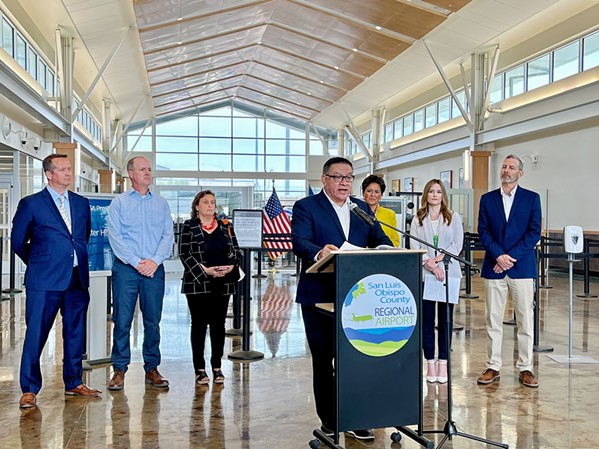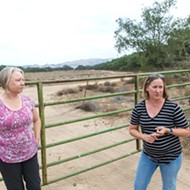California airports stand to benefit from lawmakers and scientists' attempts to disrupt 'forever chemicals'
By Bulbul Rajagopal[{
"name": "Newsletter Promo",
"id": "NewsletterPromo",
"class": "inlineCenter",
"insertPoint": "4",
"component": "15264767",
"requiredCountToDisplay": "0"
},{
"name": "Ad - Medium Rectangle CC01 - 300x250",
"id": "AdMediumRectangleCC01300x250",
"class": "inlineCenter",
"insertPoint": "8",
"component": "2963441",
"requiredCountToDisplay": "12"
},{
"name": "Ad - Medium Rectangle LC01 - 300x250",
"id": "AdMediumRectangleCC01300x250",
"class": "inlineCenter",
"insertPoint": "18",
"component": "2963441",
"requiredCountToDisplay": "22"
},{
"name": "Ad - Medium Rectangle LC09 - 300x250",
"id": "AdMediumRectangleLC09300x250",
"class": "inlineCenter",
"insertPoint": "28",
"component": "3252660",
"requiredCountToDisplay": "32"
}]
UC Riverside professor Jinyong Liu embarked on a scientific challenge as an undergraduate chemistry student when he heard people dub per- and polyfluoroalkyl substances (PFAS) as "forever chemicals."
"I just have very strong interest in destroying these chemicals," the associate professor of chemical and environmental engineering told New Times. "When most of the people said ... the carbon fluorine bond is so stable and very hard to cut, I just had my interest to understand why they're so difficult and what are easier and what are more difficult to treat ... and that's a great joy for my scientific exploration."
A plethora of funding opportunities helped. With evidence on the persistence of toxic PFAS in the environment steadily growing, researchers like Liu won access to grants that helped them contribute to mitigation efforts.
Undetectable by sight, smell, or taste, PFAS is part of everyday American life. It's found in personal care products like shampoo and dental floss, in grease-resistant food packaging, and nonstick cookware. U.S. Environmental Protection Agency (EPA) studies found that certain levels of PFAS exposure led to higher risk of prostate, kidney, and testicular cancers, and higher blood pressure in pregnant women, among other disorders.
Notably, airports around California have been scrutinized for PFAS contamination. In 2019, the State Water Resources Control Board ordered 30 airports, including the San Luis Obispo County Regional Airport, to investigate their groundwater and soil for the chemical. State regulators pinpointed pollution to a PFAS-rich foam called aqueous film forming foam (AFFF), which has been discharged into the environment since the mid-1970s through firefighter trainings.
SLO County's investigation found that most of those trainings involving the foam took place where the Cal Fire station currently sits. The county is part of a multi-district lawsuit filed in South Carolina federal court in January that alleged large companies like Buckeye Fire Equipment Company and 3M Company continually produced and sold PFAS-packed products despite knowing about the dangers of the pollutant since the end of the 1980s.
Consumers won't have to keep putting up with new sources of PFAS forever. UC Riverside's Liu's pursuit of near-complete destruction of PFAS in different water samples contaminated by fire-suppression foams resulted in almost 20 research papers about treating PFAS in water.
Most recently, with funding from the Strategic Environmental Research and Development Program, Liu and his collaborator, Yang Yang, an assistant professor of civil and environmental engineering at Clarkson University, discovered a new way of removing PFAS from heavily contaminated water using a combination of ultra-violet light, sulfite, and electrochemical oxidation. Academic journal Nature Water detailed the method in its May issue.
"This is currently the first system that can make a complete destruction of the PFAS ... in super complicated mixtures at room temperature," Liu said. "Hydrothermal approach is super powerful, but they have to use that at a very high temperature, and you have to apply the high pressure, otherwise you cannot heat the water to that temperature right. So that's what was [the] only option, but now we have the second option."
Lawmakers are working on PFAS elimination too. The 2020 National Defense Authorization Act requires the Department of Defense to phase out using PFAS-rich AFFF at all military installations by Oct. 1. The act also prohibits the Department of Defense from procuring fluorinated AFFF.
On May 16, President Biden signed the Clean Airport Agenda into law. Led by U.S. Rep. Salud Carbajal (D-Santa Barbara), Rep. Mike Lawler (R-NY), and Rep. Derrick Van Orden (R-WI), the bipartisan bills aim to curtail the threat of PFAS near airports.
It includes the Pollution-Free Aviation Sites Act, which establishes a $350 million grant program for the next five years. Airports around the country can apply for this money to help replace AFFF.
"But it also requires the Federal Aviation Administration [FAA] and the Department of Transportation to provide progress reports every six months to see how we are doing in the transition of PFAS-free firefighting foams," Carbajal told New Times.
The SLO County airport didn't respond to New Times' requests for comment. Prior reporting found that as of February, while the airport still used AFFF, it was working on a plan for transition to fluorine-free foam (F3). F3 neither contains PFAS nor does it persist in the environment and pose numerous health risks. But the newly approved F3 is available in short supply.
"You still don't have an abundance of it, and there's a lot of demand for it at the same time," said Martin Pehl, the general manager of the Santa Maria Public Airport District. "I mean, you think about it, AFFF is pretty much worthless now. Everyone's going to be getting rid of it in the state, and everyone's going to be asking for F3."
He added that it would take roughly six months for the Santa Maria airport to switch to F3. The Santa Barbara Municipal Airport is halfway through its F3 transition.
"We just placed an order, and so it's just a period of time between when you order the product and when you receive it. That is a lengthy time," said Santa Barbara Airport Director Chris Hastert. "It hasn't been approved for very long. It had to go through a stringent certification process [that] really relied on the military and their military specifications. Then as soon as the product met those specifications, then they became more widely available."
The Santa Barbara airport still uses AFFF in its aircraft rescue firefighting trucks. But it's ordered 1,420 gallons of F3 for those vehicles—more than 200 gallons for each of the three trucks and the remaining 800 gallons to replace the foam if and when it's used. Hastert said the airport only uses firefighting foam during major incidents, which have been infrequent.
Further, the airport already switched to F3 in the hangars because it was an easier replacement process.
Currently, the Santa Barbara airport is narrowing down where it might have PFAS contamination and is exploring ways to deal with it. It's on phase 4 of testing in accordance with Central Coast Regional Water Quality Control Board guidelines.
Hastert said it's been difficult to accurately determine the contamination effects on groundwater and soil.
"I'm guessing that we're not alone in this but just due to our location with the ocean and all of that, the groundwater fluctuates quite a bit," he said. "So we tried to do testing and sometimes there won't be any water there to test and then other times there is."
The Santa Barbara airport plans to complete phase 4 later this year, determine a treatment, and start applying for a portion of the $350 million grant program.
According to Carbajal, the SLO County airport and its surrounding residents played vital roles in creating urgency for such a funding program. He noted how a SLO County-contracted consultant company's sampling of 57 private wells near the airport found 52 of them loaded with PFAS- contaminated water that the EPA didn't consider safe to drink.
"Keep in mind that these foams were required by the federal government and airports have been doing this throughout the country. This now acknowledges that these are toxic foams, and we need to transition away from them," he said. "I think I was able to create a sense of urgency based on my airport in San Luis Obispo, and introduce this ... because of all that advocacy." Δ
Reach Staff Writer Bulbul Rajagopal at [email protected].
Latest in News
Readers also liked…
-

SLO police identify alleged driver who hit and killed couple
Dec 22, 2022 -

When the levee breaks: Oceano residents, county officials walk a tightrope of regulations to manage Arroyo Grande Creek, which some say led to the levee's failure in January
May 18, 2023 -

Cal Poly report highlights offshore wind's potential to spur green energy transition
Jun 8, 2023










